The Belvoirs recently had a week’s break on the Greek island of Santorini. This island destination was the first ever place I’d taken a foreign holiday, about 37 or 38 years ago (I remember the Beasty Boys were the baddies of the day, in the charts at the time), so I was interested to see how it had changed over the years. The short answer, I’m afraid, is that mass tourism has taken its toll to the detriment of its heritage. OK, the crowds have made the island wealthy, but at what cost?
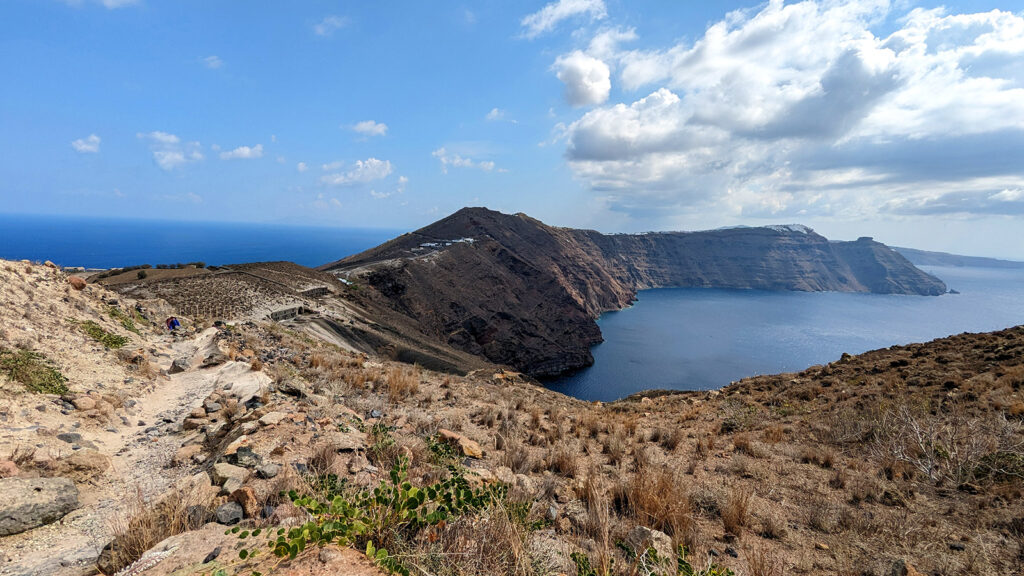
For those that don’t know, Santorini is a volcanic island that blew itself apart in the year c.1645BC. The new volcano that grew back out of the sea, Nea Kameni is still active today. The cliffs around the remaining caldera afford magnificent views of the island. Consequently, the island is one of the most popular destinations in the world, attracting millions of tourists every year. The island is famous for its stunning views, unique architecture, and rich history. But behind the picture-perfect postcards, there is a dark side to this paradise: litter.
Litter is everywhere on Santorini, from the beaches to the streets, from the caldera to the vineyards. Plastic bottles, cigarette butts, food wrappers, and other waste items are scattered all over the island, creating an eyesore and a health hazard. The problem is so bad that some locals have dubbed Santorini as “the Island of Garbage”.
How did this happen? The main culprit, I’m told, and I’ve no reason to doubt it, is over-tourism. Santorini has been overwhelmed by the sheer number of visitors, who often leave behind their rubbish without any regard for the environment or the local culture. The island’s infrastructure and services are not able to cope with the demand, and the waste management system is inadequate and inefficient. According to a recent report by the EU’s transport committee, Santorini is failing to manage the increasing numbers, spelling disaster for the local community and the environment, and putting the future of the destination at risk.
Another factor is the lack of awareness and education among tourists and locals alike. Many people do not realize the impact of their actions on the island’s fragile ecosystem, which is made entirely of volcanic rock. Some people simply do not care about preserving the island’s beauty and heritage, and only see it as a backdrop for their selfies and Instagram posts.
My ‘Marco Polo‘ Guide to Santorini tells me that there are 120 people employed on the island to pick and collect litter. I’d personally sack the entire lot of them as the place is covered with litter everywhere. It’s appalling to see, but sadly it’s endemic to the human race and I think the entire planet is truly f***ed.
We based ourselves in the small village of Pyrgos, situated on the highest point in the middle of the Island. This charming little villa was away from the hordes of tourists and afforded magnificent views over the caldera bay.
A Bus-ted Dream
Santorini may be a dream destination for many travellers with its breathtaking views, white-washed houses, and blue-domed churches. But there is one thing that can ruin your Santorini experience: the bus system. The bus system in Santorini is chaotic, unreliable, and frustrating. It is supposed to be the easiest way to get around the island, but it often turns out to be the opposite. Here are some of the problems you’ll encounter when taking the bus in Santorini:
The buses are always late. The bus schedules are more like suggestions than actual timetables. You can never be sure when the next bus will arrive or depart. Sometimes, the buses don’t even show up at all. The schedules, for what they’re worth, are just a header with ‘from’ and ‘to’ destinations and a column of times. They have no meaning as they don’t tell you the name of the bus stops on the route, or what time they stop there. The timetables don’t even refer to a service number to tie it to a particular bus, so you are reduced to just milling around with other clueless passengers until a bus turns up. Even then, it’s not obvious where the bus is going, unless you can coax the driver or conductor into revealing this, I would consider, vital information.
The buses are always crowded. They’re not designed to accommodate the huge number of tourists that flock to Santorini every year. They are often packed like sardines, with people standing in the aisles and squashed up against the doors. You can forget about personal space or comfort. You can also forget about finding a seat, especially if you have luggage or a backpack.
Nothing about the system is user-friendly or well-organized. There are no signs or announcements to indicate which bus goes where or when and sometimes, the drivers change the routes or destinations without warning or explanation.
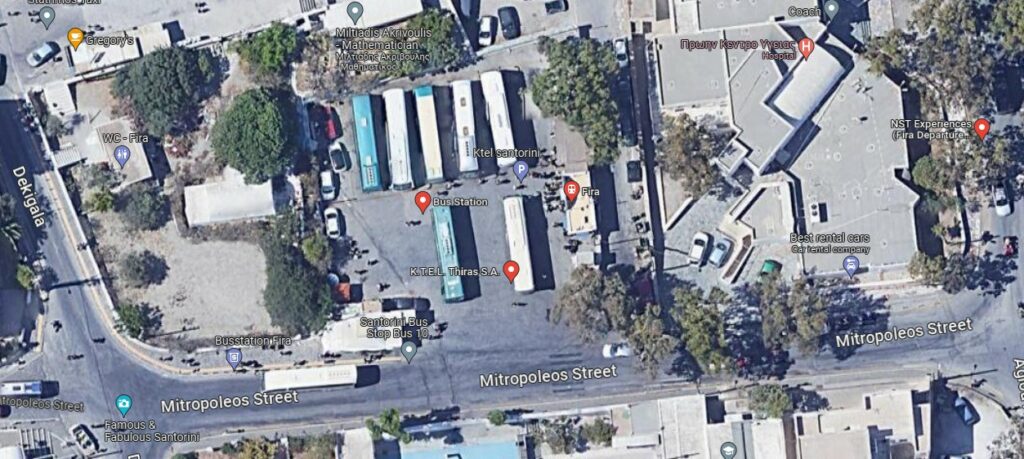
The main bus station (or rather, parking lot) in Fira is utter, utter chaos. The ticket/information office is unmanned (or it was on all of my visits), and the so-called timetables give no information except a column of meaningless times. Nobody knows which bus is going where until the driver places a tatty placard on his dashboard, approximately 16 seconds before he sets off. You wander from bus to bus, asking drivers or conductors which bus is which. If you’re lucky you will get a shrug of the shoulders or a wag of a finger. Mostly, you just get ignored. Nobody is there to help you, and nobody wants to help you. And then miraculously, approximately six seconds to departure, the conductor gets all smarmy and answers “Yiiiiiiiis, yiiiiis, of course, Pyrgos! Yiiiiiis”, like you’re an ignorant dummy and this information is freely available elsewhere.
The bus station itself is insanely dangerous with busses swinging in and out, with no barriers or pedestrian control, people milling around, paying more attention to finding out their bus rather than getting out of the way of the coach that’s reversing into them without warning or care. It’s a wonder that nobody gets killed (maybe they do), and the station’s location and the bus system in general need a major overhaul.
The network does not cover all the places you might want to visit on the island. There are only a few routes that connect the main towns and attractions, such as Oia, Akrotiri, Kamari, and Perissa. If you want to go somewhere else, you have to take two or more buses, which can be time-consuming and of course more expensive. Some places are not accessible by bus at all, such as some of the beaches, wineries, or hiking trails.
So what are your alternatives? If you want to have a hassle-free and enjoyable Santorini trip, you might want to consider renting a car, hiring an ATV (Quad Bike) – although I have more to say about these later – paying for a taxi, or renting a motorbike. These options cost a lot more than taking the bus, but they will give you more flexibility, convenience, and comfort.
On the plus side, the buses are very cheap!
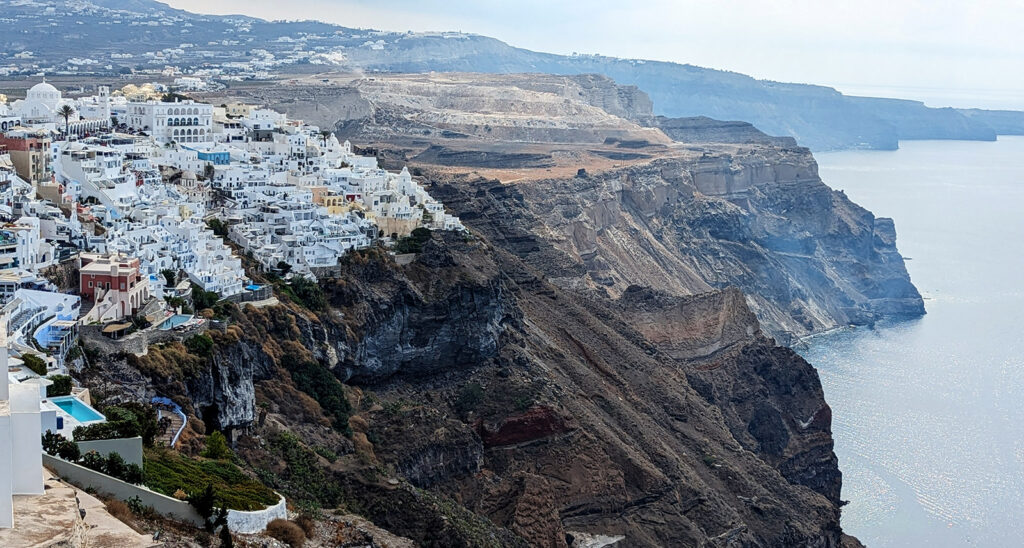
You can always walk, of course, and due to the compact size of the island, walking between towns is eminently feasible, if you have average fitness. Mrs Belvoir and I walked several journeys, including Pyrgos-Fira, Fira-Oia, Pyrgos-Kamari-Perissa, Pyrgos-Megalochori and Pyrgos-Akrotiri, although the Fira-Oia coast walk and the climb over the Mesa Vuono from Kamari to Perissa can be particularly taxing and hard on the feet. A big word of warning though: The roads are, in the main, unlit and the vast majority have no sidewalks so walking between destinations can be dodgy even on quiet roads and downright dangerous on main roads, especially at night. Some of the tracks between smaller villages such as Perissa, Pyrgos, Akrotiri and Megalachori can be cobbled back alleys but some can be just unmade dirt tracks. Be sure to pack some sturdy footwear!
I don’t mean to paint a bleak picture of the island. It has undoubtedly breathtaking scenery, the likes of which you’d have to spend a lot of money and travel many miles to see elsewhere. Sure, the place is generally crowded and expensive, but there are little villages where, although there are tourists, it’s much less intense. And if you use little family-run Tavernas you’ll save a bunch of money compared to the tourist traps of Fira and Oia, whilst supporting the local businesses.
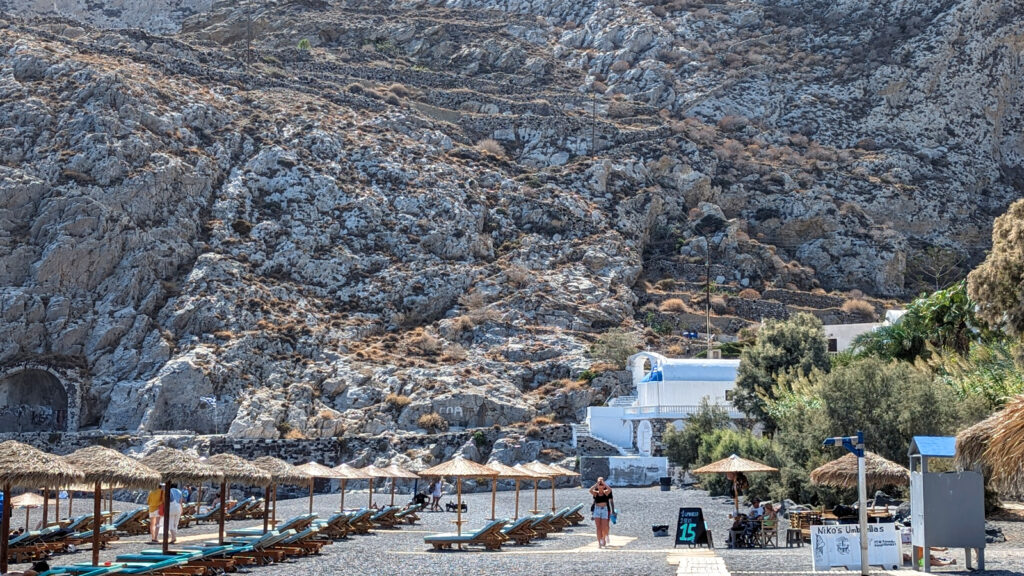
The most relaxing place we found was a little beach shack, Kamara Beach Bar, a short walk beyond the not-so-posh but still expensive eateries of Kamari Beach. Certainly not gourmet food, but inexpensive and substantial snacks and sandwiches and reasonably-price beer (if only main-stream bottled lagers) and great value hand-mixed cocktails for those so inclined. We whiled away several hours here just staring out to the sea and enjoying the eclectic mix of reggae and 80’s rock being played through a better-than-average sound system.
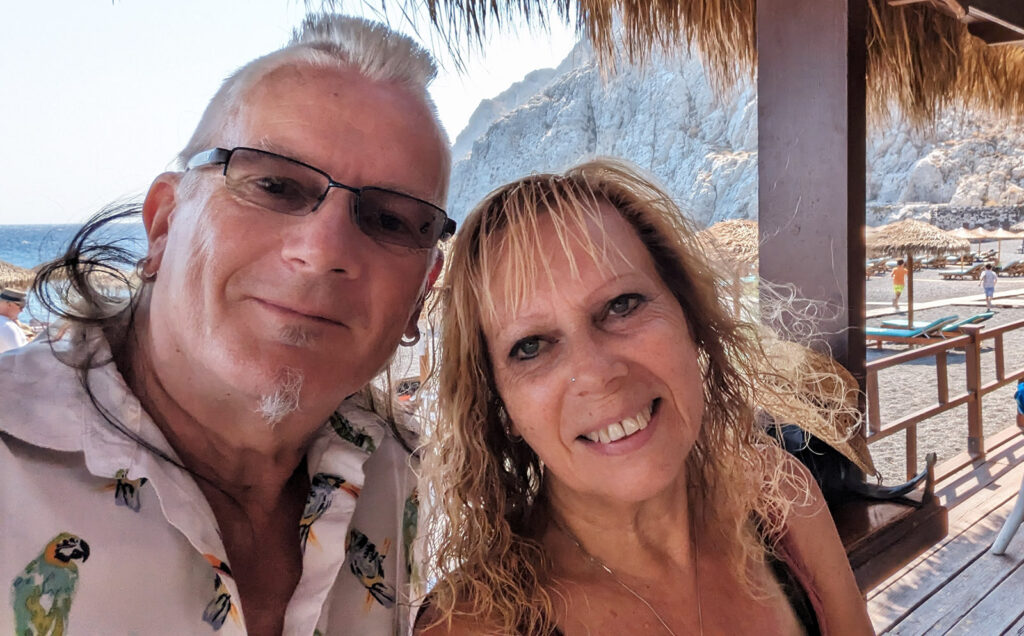
We’d actually walked here from our base in the village of Pyrgos, with the intention of taking the cheap (€5pp) water taxi around the big lump of rock that was Mesa Vuono to the village of Perissa. This service was supposed to run every 15 minutes, but after an hour, we’d seen no signs of activity. It turned out that the weather was too windy and it had been suspended for only the second time this year. Just our luck! As previously mentioned, we went up and over the Mesa, a trek that I wouldn’t recommend and have no intention of replicating for the rest of my pathetic life!
All about the beer? Sadly not!
Yeah, Santorini’s no craft beer (or any other beer for that matter) hot spot. But amongst the numerous restaurants and bars selling the ubiquitous Mythos, Alfa and other assorted mass-produced dross, there are two breweries that are trying to break the mould, namely the now well-established Santorini Brewing Company – Episkopi Gonias 847 00, and the new boys on the block, Ftleos – Karterádos 847 00.
All the beer from the Santorini Brewery is unfiltered and bottled. Apparently, they tried to sell keg products to bars when they first started production, but the bar owners had difficulties serving ‘craft’ beer on draft, so the decision was made to make output bottled only. This is also true of the bar in the brewery’s own tap room. The decision seems to have paid off, with many smaller bars and even supermarkets stocking a least some of their ‘Donkey’ range of beers. Their entire output is limited to a core range, consisting of three ‘lagered’ pales, an amber, a barrel aged, one wheat, one weisse and a saison. I tried the Yellow Donkey pale, Crazy Donkey IPA and Salty Donkey gose. All were perfectly acceptable, if unremarkable.
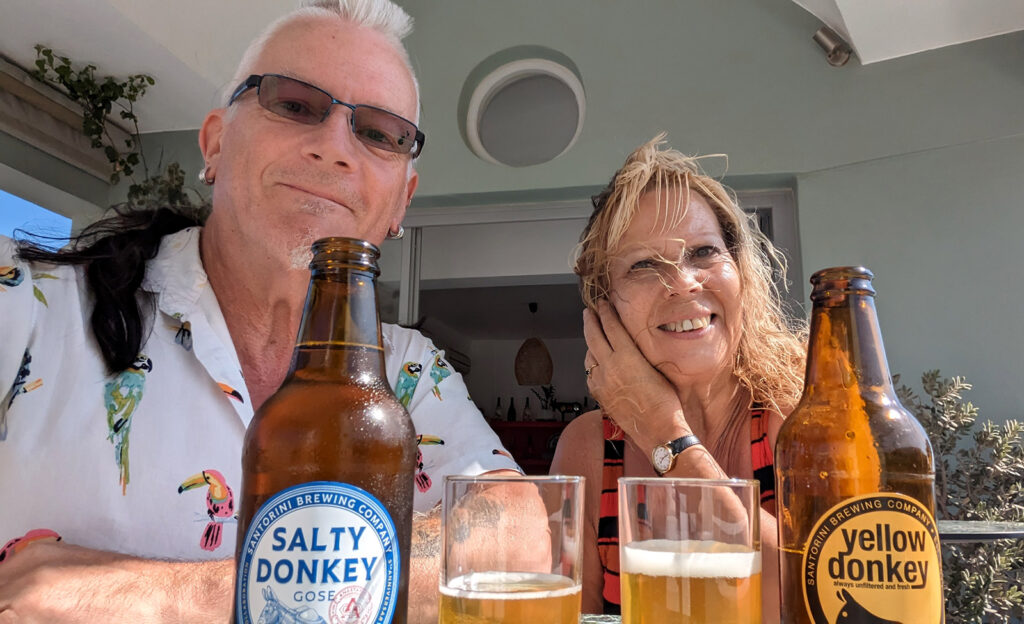
The Ftelos Brewery, on the other hand, seems like it is genuinely trying to shake the beer scene up on the Island. Starting up just a couple of years ago in 2021 (basically in the middle of the C-19 pandemic) it has a purpose-built, highly impressive set-up situated just off the main road just south of Fira.
As well as producing a diverse range of styles, it also has a gourmet kitchen and restaurant area, and it’s speciality is food-beer pairings, with a flight of six of their (draft) beers, together with a platter of light-bites, each one complimenting the beer it’s served with. I had every intention of returning here to sample this, but circumstances meant unfortunately that wasn’t to be. However, I did get to sit on the magnificent grassed roof terrace and try their Blue Monkey Pale Ale and Malt ‘N Marvel -Double IPA Hoppy Series, the latter of which was surprisingly good and would hold its own against a lot of other current European craft brewers.
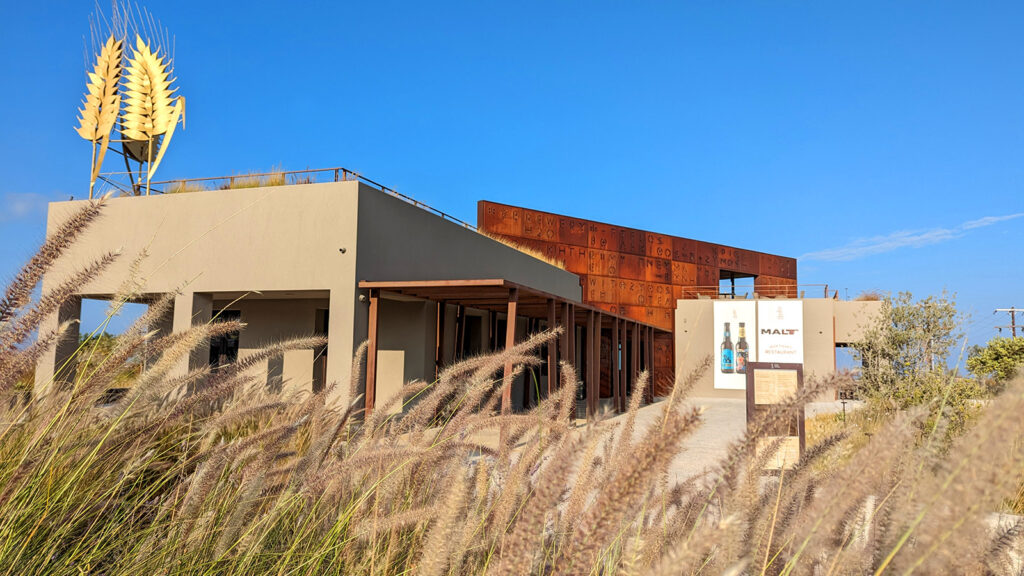
Sadly, I had the feeling that this place was in the wrong location, being out in the middle of nowhere on its own. The proprietors have obviously made a massive investment in the place and I hope they have the funds to sustain its growth in the coming years and expand the availability of their beers into the surrounding towns and villages, as Santorini Brewery has done.
Wine is fine.
If beer’s not your bag, man, then Santorini has no less than 22 domestic wineries. We stumbled in on one during our walk around the quiet village of Megalchori. Gavalas Winery – Megalochori 847 00, produces around 70,000 bottles per year, mostly from grapes native to the island.

On our walks around the island, grape vines are evident everywhere. The plants are cultivated under baskets to keep them low and spread out to protect them from the island’s frequent and strong winds.
Even so, it was hard to imagine that, with 22 wineries, there were enough grapes to go around and for each one to output 70,000 bottles per year.
It’s no doubt that Santorini is one of the richest Greek islands. But this wealth comes with a big environmental price. The beauty of the island is somewhat blighted by the amount of tourist visitors. The serenity that I experienced all those yours ago has been destroyed, with the constant rumble of Quad Bikes pervading the whole island, often into the small hours. The fleets of tour coaches and cruise liners keep their engines running constantly, polluting the air and the cars and mopeds clog up the picture-book cobbled streets of the towns. It’s all very sad. This is now typical of many tourist destinations; In Europe Venice, Pisa, and Bruges are among destination towns looking at ways of reducing tourist hordes whilst still reaping the benefits. I’ll be interested to see what solutions they come up with, if any.
Some further pics from our Santorini break below.


Comments 1
Pingback: To the Tourism Minister's Chagrin - Greeks Shunning More Tourists